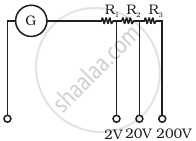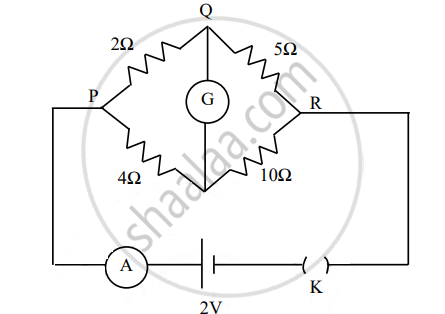Advertisements
Advertisements
प्रश्न
A coil of radius 10 cm and resistance 40 Ω has 1000 turns. It is placed with its plane vertical and its axis parallel to the magnetic meridian. The coil is connected to a galvanometer and is rotated about the vertical diameter through an angle of 180°. Find the charge which flows through the galvanometer if the horizontal component of the earth's magnetic field is BH = 3.0 × 10−5 T.
उत्तर
Given:-
Radius of the coil, r = 10 cm = 0.1 m
Resistance of the coil, R = 40 Ω
Number of turns in the coil, N = 1000
Angle of rotation, θ = 180°
Horizontal component of Earth's magnetic field, BH = 3 × 10−5 T
Magnetic flux, ϕ = NBA cos 180°
⇒ ϕ = −NBA
= −1000 × 3 × 10−5 × π × 1 × 1 × 10−2
= 3π × 10−4 Wb
dϕ = 2NBA = 6π × 10−4 Wb
\[e = \frac{d\phi}{dt} = \frac{6\pi \times {10}^{- 4}}{dt}\]
Thus, the current flowing in the coil and the total charge are:-
\[i = \frac{e}{R} = \frac{6\pi \times {10}^{- 4}}{40dt} = \frac{4 . 71 \times {10}^{- 5}}{dt}\]
\[Q = \frac{4 . 71 \times {10}^{- 5} \times dt}{dt}\]
\[ = 4 . 71 \times {10}^{- 5} C\]
APPEARS IN
संबंधित प्रश्न
Obtain the expression for current sensitivity of moving coil galvanometer.
An ideal voltmeter has _______.
(A) low resistance
(b) high resistance
(C) infinite resistance
(D) zero resistance
A galvanometer of resistance G is converted into a voltmeter to measure upto V volts by connecting a resistance R1 in series with the coil. If a resistance R2 is connected in series with it, then it can measures upto V/2 volts. Find the resistance, in terms of R1 and R2, required to be connected to convert it into a voltmeter that can read upto 2 V. Also find the resistance G of the galvanometer in terms of R1 and R2
Why is it necessary to introduce a cylindrical soft iron core inside the coil of a galvanometer?
Two moving coil meters, M1 and M2 have the following particulars:
R1 = 10 Ω, N1 = 30,
A1 = 3.6 × 10–3 m2, B1 = 0.25 T
R2 = 14 Ω, N2 = 42,
A2 = 1.8 × 10–3 m2, B2 = 0.50 T
(The spring constants are identical for the two meters).
Determine the ratio of
- current sensitivity and
- voltage sensitivity of M2 and M1.
Explain how moving coil galvanometer is converted into a voltmeter. Derive the necessary formula.
Define current sensitivity of a galvanometer.
Write current sensitivity of a galvanomete S.I. unit.
Explain, giving reasons, the basic difference in converting a galvanometer into (i) a voltmeter and (ii) an ammeter?
A galvanometer coil has a resistance of 12 Ω and the metre shows full scale deflection for a current of 3 mA. How will you convert the metre into a voltmeter of range 0 to 18 V?
The current sensitivity of a galvanometer is defined as ______.
The conversion of a moving coil galvanometer into a voltmeter is done by ______.
A multirange voltmeter can be constructed by using a galvanometer circuit as shown in figure. We want to construct a voltmeter that can measure 2V, 20V and 200V using a galvanometer of resistance 10Ω and that produces maximum deflection for current of 1 mA. Find R1, R2 and R3 that have to be used.

A galvanometer shows full-scale deflection for current Ig. A resistance R1 is required to convert it into a voltmeter of range (0 - V) and a resistance R2 to convert it into a voltmeter of range (0 - 2V). Find the resistance of the galvanometer.
How is current sensitivity increased?
Assertion: When an electric current is passed through a moving coil galvanometer, its coil gets deflected.
Reason: A circular coil produces a uniform magnetic field around itself when an electric current is passed through it.
The figure below shows a circuit containing an ammeter A, a galvanometer G and a plug key K. When the key is closed:

